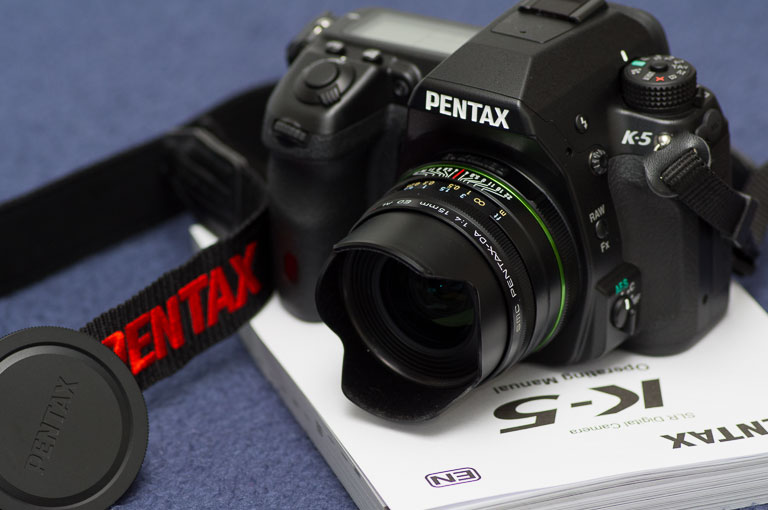Pentax K-5 review
My choice for an APS-C DSLR

Simply one of the best APS-C DSLRs you can buy. The 14-bit sensor offers tremendous dynamic range, allowing raw files processed in Lightroom 4 to exhibit fantastic detail in all tonal regions. Judging from more technical reviews, it appears to offer the best image quality to be found short of full-frame. And Pentax’s ergonomics and user interfaces are always comfortable and intuitive, offering easy access to the controls you actually want. To top it all off, I’m quite fond of the styling as well.
Shortcomings
The K-5 is certainly not the perfect tool for all imaging tasks. Here are a few areas where it comes up short:
Video
Video is an area where Pentax unquestionably lags behind its competitors. The only framerate offered at 1080p is 25fps (not 24), and there’s no 60fps option at any resolution. The codec used is a variant of MJPEG that breaks many open-source tools (thankfully GStreamer works fine). There’s no autofocus while filming and no focus peaking (though the latter isn’t surprising given its age). All-in-all, video on the K-5 is pretty primitive.
Now that’s not to say that it’s useless. You’ll still get a high-resolution picture with the option of shallow depth-of-field. And 25fps is fine for Internet posting. But this is by no means a cinematographer’s DSLR.
Autofocus
This is not one of Pentax’s strong suits. Phase-detection autofocus seems to lack precision, and even live-view autofocus can often be improved manually. Note that AF micro adjustment cannot address these issues (focus accuracy is moot if focus precision is poor). Thankfully, most of Pentax’s lenses have Quick-Shift, facilitating manual override.
Sync speed
The maximum sync speed of the K-5 is a lethargic 1/180s, and if your shutter speeds exceeds that, it won’t even attempt to fire the flash. This is an unfortunate limitation when trying to overpower ambient light with flash. For comparison, most Nikon cameras will sync at 1/250s.
No mechanical aperture coupling
This is not a competitive shortcoming, but with Pentax’s huge selection of legacy lenses, it’s a shame that glass predating the mid-1980s has no way of conveying its aperture to the camera. While stopdown metering is quick and easy, fulltime metering would breathe new life into these old lenses.
Camera strap
Pathetic - buy a replacement immediately (I recommend those by Capturing Couture).
Strengths
Image quality
The image quality is simply fantastic – details are sharp, dynamic range is high, and noise is low (in fact, at high ISOs I find dynamic range reduction to be a bigger issue than noise, and even that doesn’t bother me until ISO 6400). The exposure latitude of raw files is extraordinary – I’ve had Lightroom pull out detail from 10 stops deep in shadow. However, Adobe doesn’t provide profiles to mimic any of Pentax’s JPEG looks, so you’ll often find yourself adding a fair bit of punch by hand.
Handling
I have always found Pentax interfaces to be the most intuitive of any camera manufacturer, and this continues to hold true with the K-5. Dedicated buttons are provided for ISO and exposure compensation, and aperture and shutter speed can be overridden in Program mode with the flick of a dial. There is also a dedicated button for triggering autofocus and one for exposure lock, though I would have preferred it if they switched positions (the AF button is slightly awkward, though I’m nit-picking here; and while I’m nit-picking, I’ll note that exposure lock doesn’t lock white balance).
The more advanced functions provided by the camera are clearly photographer-oriented: things like mirror lock-up, 5-shot exposure bracketing at 2-stop intervals, etc. This camera was clearly designed as a tool, and for that I am grateful.
Build quality
The camera feels extremely solid – much more so than consumer models like the K-x (though it’s significantly heavier as well). Weather sealing gives you confidence in the rain, and freezing temperatures are not a problem. Battery life is superb – two batteries were more than enough for a 10-day backpacking trip in Banff. Taken together, these properties make the K-5 fantastic for outdoor adventure.
Conclusion
A great camera alone is not reason enough to invest in a lens system, but as far as cameras go, the K-5 is a great one indeed. It does what a good photographic tool should do: provide an intuitive interface to capture high-quality images. I bought one after a great deal of online research, and I’ve never looked back.